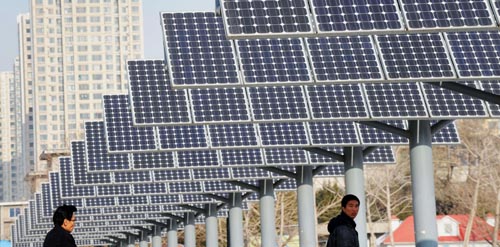[Viewpoint] Sunny outlook for solar industry

Residents walk pass a group of solar power panels installed for public electricity supply in Shenyang, in northeast China’s Liaoning Province, on Dec. 17, 2009. China is to invest more than three trillion yuan (440 billion dollars) in environmental protection. AFP
Entering 2009, banks were not the only industry that seemed headed for a rough ride in the global financial crisis. The outlook for the renewable energy sector was as grim, with the solar energy industry predicting negative growth, considering its weak economic feasibility compared with fossil fuels. However, it defied expectations. According to Solarbuzz, an international solar energy research firm, the solar energy market grew to 6.4 gigawatts in 2009, up 8 percent from 2008. Europe accounted for 74 percent of total demand, with Germany, Italy and the Czech Republic the top consumers.
The keywords for the 2009 solar energy market were “drastic change.” The biggest change was in the price of a solar module, an assembly of photovoltaic cells commonly known as a solar panel. After riding a boom in the industry since 2004, the module price sharply reversed when the global financial crisis erupted in the second half of 2008. In June 2008, the price per watt of a single module was $4. By July 2009, the price had halved to $2. For all of 2009, the average price is estimated to have fallen by 38 percent from 2008.
The second change was the dominance of a handful of companies. In 2009, the market share of the top seven solar companies surged to 74 percent from 44 percent in 2008. Another change was No. 2 ranked First Solar moving to the top, replacing Q-Cells, which dropped to third. As such, the solar energy market underwent a major transformation in the wake of the global financial crisis.
Going forward, three trends are expected. First, at around the outbreak of the financial crisis, solar energy shifted to a buyer’s market from a seller’s market, and this trend will likely continue. On the back of a rapid growth in solar market, competition among major players increased in terms of production capacity. A total of 9.3 gigawatts of solar cells were produced in 2009, which means supply outstripped demand by 45 percent. This year, supply also will outweigh demand, the industry forecasts. To this end, the price of a solar energy module is likely to drop to $1.50 per watt, down 25 percent from $2 in the fourth quarter of 2009, further fueling buyer’s market conditions this year.
The second trend is industry concentration and the rise of China. Investment plans of the 11 major solar cell manufacturers, including China, Japan, Europe and the U.S., show an increase of 2.8 gigawatts this year, lifting their production to 10.5 gigawatts from 7.7 gigawatts in 2008. Five companies plan to secure 1 gigawatt capacity in 2010. That would have been enough to meet total global demand in 2009.
Meanwhile, China has four among the top seven solar energy companies in the world. Chinese companies took up 21 percent market share in 2008, which rose to 37 percent in 2009. On the back of these four companies’ increase of market share, China produced 4.6 gigawatts worth of solar cells in 2009, taking up 49 percent of total world market share. The top four Chinese companies plan to increase a total of 1.1 gigawatts in 2010, which is 40 percent of the total production capacity increases. The biggest advantage of Chinese solar energy companies is their low operating expenses; their module production costs are 62 percent of their European rivals’ costs. Chinese companies will likely expand investments based on their low-cost production system, solidifying their cost competitiveness.
Finally, CdTe thin film solar cells will be commercialized in earnest. According to Displaybank, a market research firm, production in CdTe thin film solar cells increased twofold to 1,180 megawatts in 2009 from 515 megawatts in 2008, taking up 12.3 percent of total solar cells. Production costs of thin film solar cells are relatively low, but mass production is difficult. First Solar succeeded in mass production to establish a monopolized niche in the solar energy market. CdTe thin film solar cell manufacturing costs are only 56 percent that of crystalline solar cell module manufacturing costs.
As the solar energy market conditions change rapidly, pioneering companies are leading the market, and Korean solar energy firms have yet to secure global-level capability. Chinese products accounted for 53 percent of Korea’s market in 2009, with Korean firms’ share being only 23 percent. The competitiveness of Korean firms’ solar technology is behind their European and U.S. peers, and their cost competitiveness trails Chinese firms. To catch up, Korean companies need to move beyond highly efficient technology to low-cost highly efficient technology. A vertical integration business model will also be crucial to securing stable profits.
*The author is a research fellow at Samsung Economic Research Institute.
By Cho Yong-Kwon










with the Korea JoongAng Daily
To write comments, please log in to one of the accounts.
Standards Board Policy (0/250자)